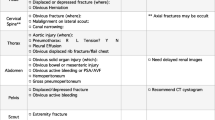Abstract
Purpose
To test the hypothesis that an automated post-processing workflow reduces trauma panscan exam completion times and variability.
Methods
One-hundred-fifty consecutive trauma panscans performed between June 2018 and December 2019 were included, half before and half after implementation of an automated software-driven post-processing workflow. Acquisition and reconstruction timestamps were used to calculate total examination time (first acquisition to last reformation), setup time (between the non-contrast and contrast-enhanced acquisitions), and reconstruction time (for the contrast-enhanced reconstructions and reformations). The performing technologist was recorded and accounted for in analyses using linear mixed models to assess differences between the pre- and post-intervention groups.
Results
Exam, setup, and recon times were (mean ± standard deviation) 33.5 ± 4.6, 9.2 ± 2.4, and 23.6 ± 4.7 min before and 27.8 ± 1.5, 8.9 ± 1.4, and 18.9 ± 1.7 min after intervention. These reductions of 5.7 and 4.7 min in the mean exam and recon times were statistically significant (p < 0.001) while the setup time was not (p = 0.49). The reductions in standard deviation were statistically significant for exam and recon times (p < 0.0001) but not for setup time (p = 0.13). All automated panscans were completed within 36 min, versus 65% with the traditional workflow.
Conclusion
Automation of image reconstruction workflow significantly decreased mean exam and reconstruction times as well as variability between exams, thus facilitating a consistently rapid imaging assessment, and potentially reducing delays in critical management decisions.





Similar content being viewed by others
References
Blow O, Magliore L, Claridge J et al (1999) The golden hour and the silver day: detection and correction of occult hypoperfusion within 24 hours improves outcome from major trauma. J Trauma Acute Care Surg:2–12
Howard JT, Kotwal RS, Santos-lazada AR et al (2017) Reexamination of a battlefield trauma golden hour policy. J Trauma Acute Care Surg 84:11–18
Novelline RA, Rhea JT, Rao PM, Stuk JL (1999) Helical CT in emergency. Radiology 213:321–339
Soto JA, Anderson SW (2012) Multidetector CT of blunt abdominal trauma. Radiology 265:678–693
Hinzpeter R, Boehm T, Boll D et al (2017) Imaging algorithms and CT protocols in trauma patients: survey of Swiss emergency centers. Eur Radiol 27:1922–1928
Nguyen D, Platon A, Shanmuganathan K et al (2009) Evaluation of a single-pass continuous whole-body 16-MDCT protocol for patients with polytrauma. Am J Roentgenol 192:3–10
Wortman JR, Uyeda JW, Fulwadhva UP, Sodickson AD (2018) Dual-energy CT for abdominal and pelvic trauma. RadioGraphics:586–602
Sodickson AD (2012) Strategies for reducing radiation exposure in multi-detector row CT. Radiol Clin N Am 50:1–14
Gunn ML, Kool DR, Lehnert BE (2015) Improving outcomes in the patient with polytrauma. Radiol Clin N Am 53:639–656
Jeavons C, Hacking C, Beenen LF, Gunn ML (2018) A review of split-bolus single-pass CT in the assessment of trauma patients. Emerg Radiol 25:367–374
Korner M, Krotz M, Kanz K et al (2006) Development of an accelerated MSCT protocol (triage MSCT) for mass casualty incidents: comparison to MSCT for single-trauma patients. Emerg Radiol 12:203–209
Mueck F, Wirth K, Muggenthaler M et al (2016) Radiological mass casualty incident (MCI) workflow analysis: single-Centre data of a mid-scale exercise. Br J Radiol 89:1–6
Author information
Authors and Affiliations
Corresponding author
Ethics declarations
Conflict of interest
The authors declare that they have no conflict of interest.
Additional information
Publisher’s note
Springer Nature remains neutral with regard to jurisdictional claims in published maps and institutional affiliations.
Rights and permissions
About this article
Cite this article
Yu, H., Bay, C.P., Czajkowski, B. et al. Automated CT reformations reduce time and variability in trauma panscan exam completion. Emerg Radiol 29, 461–469 (2022). https://doi.org/10.1007/s10140-022-02031-7
Received:
Accepted:
Published:
Issue Date:
DOI: https://doi.org/10.1007/s10140-022-02031-7




